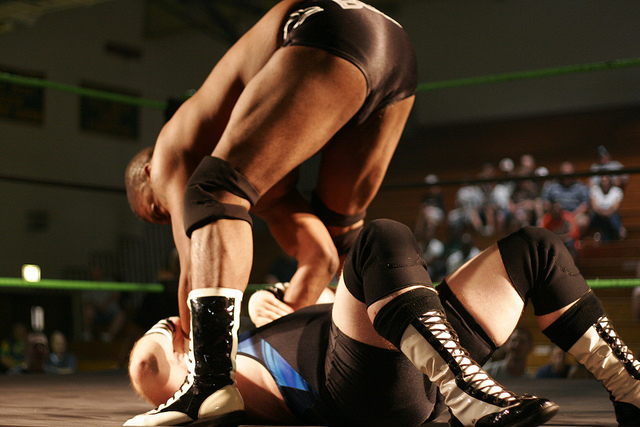It is quite difficult to suggest that pro wrestling is, or can be, legitimately avant-garde. Barthes’ assertion is true, that “In wrestling, nothing exists except in the absolute, there is no symbol, no allusion, everything is presented exhaustively…”, and consequently, its character is opposed necessarily with Greenberg’s definition of the avant-garde, which must push beyond public approval to define itself in exponentially broader and more abstract terms.
During the 1990s though, the wrestling establishment was forced to embrace a narrative style that incorporated the real-life relationships between wrestlers, and of the internal workings of the companies themselves as the two major organisations fought for their survival.
Thus, wrestling became at odds with its traditional value of kayfabe, which was to rigidly uphold the guise of presenting its fiction as reality within its narratives.
Such a shift in ideology, for a number of years led to a boom in audience figures, and fundamentally transformed their engagement with wrestling as a traditional art-form. Paradoxically, wrestling has genuinely displayed a capacity for the avant-garde, but only in the context of mass consumption.
Roland Barthes’ World of Wrestling
“Wrestling is not a sport, it is a spectacle, and it is no more ignoble to attend a wrestled performance of Suffering than a performance of the sorrows of Arnolphe or Andromaque.”
It is virtually impossible to write critically about professional wrestling without citing Roland Barthes, whose essay on the subject featured in his seminal 1957 book Mythologies. The sport itself is not sport at all, but theatre: a grandiose battle of ideology between noble good and base evil, and for centuries it has been a staple working-class pastime.
In Europe, Asia, and then so significantly in North America, wrestling is performed in working men’s clubs, at fairgrounds, in backyards, but more recently also in arenas and on primetime television.
Although wrestling is still performed globally, relatively unchanged from its traditional form, it is in North America – since the latter part of the twentieth century – that the audiences became so large that wrestling was able to evolve as an art form, from backstreet proletarian theatre to a cacophony of engrossing and intertwining realities that permeated global popular culture.
Of course there are flaws in both the practice and the industry in wrestling, not least because the American capitalist system that drove – and indeed funded – the radical changes in the sport (or what Barthes calls a “stage-managed sport”) and expansion of its industry is the antithesis of folk art, but because its structure is largely an anathema to the avant-garde. As Barthes states, “wrestling is a sum of spectacles, of which no single one is a function”, and such a lack of subtext is inherently difficult to paint as avant-garde, which in turn has the definitive quality of breaking the established boundaries of its given subject.
Without question, the sum of opaque spectacles that Barthes speaks of is more naturally inclined to the cultural output that Dwight MacDonald criticised as a debased form of high culture – one that imitates the values of high art but ultimately only as a tool of class hegemony. The sport itself is certainly not genuine folk art in its commercial form, yet wrestling is worthy of serious analysis due to a paradox of this very nature.
In wrestling, it is precisely its most commercially-driven, mass-cultural guise that has created the environment in which the avant-garde has emerged; subconsciously, perhaps finitely, but almost certainly and palpably.
Kauffman, Kayfabe, and Situationism
In his 1939 essay Avant-Garde and Kitsch, Clement Greenberg considers the avant-garde to be diametrically opposed to art as an artefact of popular consumption, which he labelled ‘kitsch’. Avant-garde then, etymologically rooted in the ultimate protection of the advanced, of the future, and kitsch represent the poles of the perpetually-expanding parameters of art and culture. When discussing culture in this context it is most appropriate to consider Matthew Arnold’s 1975 definition:
…we are fond stickers to no machinery, not even our own; and we have no doubt that perfection can be reached without it, […] But it can never be reached without seeing things as they really are; and it is to this, therefore, and to no machinery in the world, that culture sticks fondly.
For Arnold, culture represents the divine aspiration; truth, enlightenment, ‘sweetness and light’, and half a century later the emergence of mechanical reproduction capped the liberation of art from realism. Although realist artwork remained popular, for Greenberg the avant-garde is not what is wanted by consumers of art, but what is needed for the progress of humanity, and the two can never be the same.
Pro-wrestling, as a traditional medium of narrative performance, lies firmly in the former category, and unashamedly so. To return to Barthes briefly, “In wrestling, nothing exists except in the absolute, there is no symbol, no allusion, everything is presented exhaustively.” Wrestling is undoubtedly, and without hesitation or uncertainty, kitsch. However it is not the base ideological narrative performed physically in wrestling that is of concern here, but its metanarrative.
The first significant example of pro wrestling’s unlikely affair with the avant-garde is owed to the work of the late American situationist, Andy Kaufman. But in order to contextualize his work fully within the sport, it is necessary to first understand the most fundamental and bespoke characteristic of wrestling: kayfabe. This is the notional depiction, summed up neatly in Coombs and Batchelor’s American History through American Sports…, that all participants and actions involved in the wrestling performance are entirely real.
Kayfabe not only provides a natural environment for a situationist such as Kaufman to work in, but mandates an immediate scrutiny of its own. If though, as Barthes suggested, the principle of genuine competition is of no importance to wrestling, why insist upon a veneer of reality?
Various terminology traditionally used in the wrestling business suggests a multi-faceted attitude towards reality in wrestling. Until relatively recently, terms such as “smarts” and “marks” were used commonly – with their roots firmly in carnival culture – to refer respectively to fans aware of the methods invoked in wrestling performance, and to those ignorant of such methods. The implication of this being, again for Coombs and Batchelor, that many believed kayfabe reality to be authentic, or even that they believe it wilfully. Ultimately, pro-wrestling is the perfect structuralist art form; its power over its audience existing at the behest of a delicate mixture between professional tact and their own complicity.
Kaufman however, with a genuine love of wrestling and the notion of kayfabe, was able to use this structure to permeate mainstream entertainment and subvert the traditional boundaries of wrestling, show-business, and reality, turning the national media into a wrestling storyline that upheld kayfabe flawlessly – even beyond his death.
In 1980 Kaufman, at the time well-known as a comedy actor, had begun inviting women to wrestle him as part of his routine. He declared himself the world ‘inter-gender’ champion, before developing a rivalry with Jerry Lawler that lasted from 1981 until shortly before his death in 1984.
As a situationist, it was Kaufman’s commitment to upholding kayfabe (even after death, thanks to his Tony Clifton persona – and his natural showmanship – that made his transition into a wrestling ring so successful and simultaneously elevate his wresting feud to unexpected heights outside of the ring.
Kayfabe, the backbone of the aforementioned ideological structure binding wrestling and its audiences together, is a sensitive and often unpredictable phenomenon. It is worthy of note that before Kaufman started working with Lawler’s independent wrestling company in Memphis, he had been turned away by the much larger WWF (now WWE). Its owner Vince McMahon, the father of the current owner, had cited a reluctance to bring Kaufman – a Hollywood personality – into his business through fear of jeopardising kayfabe.
But Kaufman, through his relentless harassment of women and derision of the local people, was an instant hit in Memphis, as shown in Margulies and Orr’s 1989 documentary I’m From Hollywood. As Margulies would later say in 2014’s The Truth…Finally, “the audience hated him, “which seemed to please him”. It had always been Kaufman’s goal to illicit the most profound response possible from an audience, whichever way that fell.
Wrestling trades in binary notions of good and evil and Kaufman’s adeptness in exploiting that meant he could become a successful wrestling persona in spite of his existing celebrity. But the most important part of this feud – and indeed from a critical perspective – was when Kaufman, who had transitioned from Hollywood to wrestling in Memphis, brought his wrestling persona back into Hollywood with an appearance alongside Lawler on the David Letterman Show, culminating in a physical assault on Kaufman by Lawler. The notion of doubt that McMahon had sought to shield his wrestling company from emerged as the most powerful tool of Kayfabe.
Was this real? If so, the neck brace worn by Kaufman on the show – allegedly a result of his match with Lawler a week prior – could be real too. The lines were completely blurred (the injuries, from which Kaufman spent days in hospital in order to appear more convincing, were a result of a piledriver from Lawler.
A piledriver is an illegal move in wrestling, due to its genuine capacity to cause injury; but, as Barthes says, “the forbidden move becomes dirty only when it destroys a quantitative equilibrium…” In the broader ideological context, Lawler was justified – even required – to punish Kaufman in this way), and the truth would not be known until a decade after Kaufman’s death.
The Montreal Screwjob and the Monday Night Multiverse
If Kaufman’s feud with Lawler had convinced spectators that some reality could exist in wrestling, then the “Montreal Screwjob” confirmed it. In 1997, WWF champion Bret Hart performed in his last match for the company before moving to rivals WCW (World Championship Wrestling). As Hart would have to vacate the championship before he left, he proposed – unwilling to lose his last match in his hometown – the match ended in a no contest, before appearing on the live show the following night to hand over the belt in a farewell speech.
Vince McMahon (Jr., who by now had taken control of the company) agreed, but called the match to an abrupt halt (McMahon was a ring announcer at this point), falsely claiming that Hart had submitted. The fans sensed something was amiss, and the resulting fracas – Hart spat at McMahon from the ring and later gave him a black eye – confirmed this.
The following night on Raw, the weekly WWE broadcast, McMahon reflected on the incident directly; it was incorporated in the storyline narrative in an unprecedented way, in a move that simultaneously confronted the breach of the fourth wall on the previous night and confirmed McMahon as the legitimate owner of the company.
Thereafter, he retained this role in the narrative and left his position as a commentator, ending a history of kayfabe authority figures in the company (the likes of Jack Tunney had been portrayed as authority figures in the narrative up to this point, who would book matches and discipline wrestlers within the storylines). The effect that this had from a narrative-performance perspective has been neatly summed up by WNYC’s Radiolab podcast in 2015:
“…there are these tiny injections of truth into this world in really unexpected moments. What that does is it puts everyone on high alert for those moments, and when everyone is on high alert for those moments all the time, every moment has the potential to be true […] and when you are watching for those injections, it completely changes how you are engaging with the art form.”
Such a revolution in engagement heralded the start of an extraordinarily prosperous time for pro wrestling, and particularly WWE that emerged from the era as the industry’s unrivalled superpower. The event had occurred at the height of a ratings war between WWE and its rival WCW, dubbed the Monday Night War due to the head-to-head scheduling of their flagship shows on mainstream cable networks in the US.
Live wrestling shows subsequently opened up to include the internal workings of respective companies, with speculation rife amongst fans on which wrestlers would defect to their rivals. Occasionally this speculation was successfully harnessed in storylines, such as with the NWO’s move to WCW in 1996 (as explained in the 2004 WWE documentary The Monday Night War), but on other occasions the moves were public knowledge. The Montreal Screwjob, in this context, is somewhat of an incident that encapsulated and magnified wholly the environment of the time.
https://www.youtube.com/watch?v=XGYYMVlVTD8
There have been numerous high-profile reality ‘injections’ of this sort since then (a notable example being the love triangle between Matt Hardy, Lita, and Edge in 2005) which were equally incorporated into storylines to great fanfare, but the bigger picture is of an art-form that utilizes reality and fiction in a uniquely unpredictable manner.
The “real” or “fake” dichotomy is covered throughout academic discourse on professional wrestling, and this is not the first example by any means of storylines incorporating real-life events. Sharon Mazer discussed, in 1998’s Professional Wrestling: Sport and Spectacle, a storyline head injury to Shawn Michaels in WWF that was used to justify his need for treatment to a legitimate injury. But during the Monday Night Wars (also the dawn of live broadcasting for WWF) the company could not preempt some of the on-air developments, and certainly not those of its rival WCW show.
The best comparison that can be drawn here is to magic, which has a similar set of internal values concerning industry secrets to wrestling. Imagine watching a magician perform with the knowledge that some of their tricks could be real. This, almost entirely by chance, is the dynamic that had now been introduced to professional wrestling.
The End of Kayfabe? Wrestling in the Age of Social Media and MMA
Of course, for all its erratic multiplicity of interwoven realities has sporadic artistic depth, pro-wrestling is still practically GM designed for commercial exploitation. Whilst consumer capitalism has had its way with most sports – and in particular, those that once represented quintessentially working class interests – only wrestling is as predictable from a marketing perspective. Simply, where the most popular football players or boxers may succumb to a loss of form or ability over a short or long period of time, a popular wrestler can remain a consistently strong competitor for virtually as long as is required of them (injury permitting).
However, with the element of unpredictability largely removed (save the aforementioned injections of sporadic reality), the success or failure of wrestling to intrigue an audience is entirely in the hands of the companies themselves. Since the Montreal Screwjob – and due to the coinciding advent of the internet – fans that attend wrestling shows became mainly comprised of what had been traditionally referred to as “smart marks”, or smarks.
However, as the industry has attempted to adapt to the demands of technology – particularly social media – and increasingly knowledgeable audiences, there has been a marked disengagement with its traditional principle of kayfabe. A recent example of this has come in the form of a Twitter ‘selfie’ by a number of WWE wrestlers, some of whom were billed as adversaries at the time. TVTrax made note of this in 2015:
“…there’s Roman Reigns and Bray Wyatt stood right next to each other, smiling, flexing their biceps – after sitting through Roman on Monday night trying to convince the crowd, “this is real life”…”
Vlogs such as this form a central part of contemporary wrestling fan culture, and epitomise its precarious relationship with reality and fiction – at once craving the excitement of injected reality whilst lamenting the betrayal of traditional industry values.
For wrestling fans, such a cavalier attitude towards kayfabe is a misappropriation of the delicate fourth-wall dynamic, although the above analyst is more critical of the double-standards employed by WWE bosses over their attitude towards kayfabe (Stephanie McMahon and Triple H, two leading executives as well as characters in the company, list “playing a bad guy on TV” as part of their social media profiles, as TVTrax explained).
The multimedia demands of the postdigital age have reinforced this with official WWE content (such as the Stone Cold podcast) speaking out of character about the storyline, but this does not necessarily mean kayfabe is dead. As Brian Zane suggested in 2013, kayfabe
“in the internet age has clearly evolved. It’s no longer about living your gimmick and flat out lying to fans – they’re too smart for that. What kayfabe is today, is essentially wrestling stripped down to its very core essence. It’s telling the story within the confines of the ring and making people believe in it.”
This is a key analysis that correlates neatly with the previous example, which goes on to discuss pre-internet instances of wrestlers breaking kayfabe. Although wrestlers have not fully committed to kayfabe outside of the ring for decades, it is only the technology of this century that has caused it to become so evident.
It is of no surprise then, that in an age where consciousness and enlightenment are expected of an audience, and where mainstream wrestling has been aimed at an increasingly younger demographic, the sport of Mixed Martial Arts – particularly the Ultimate Fighting Championship – has emerged as a popular alternative to wrestling.
Although many MMA fans and competitors consider UFC to be the antithesis of wrestling, the two are categorically linked. Joe Rogan, a commentator for UFC, has also been an outspoken critic of professional wrestling and even condemned the idea that the two share a target demographic in 2014.
“It’s not the Goddamn same […] One of them is real. One of them is people battling for their lives in the most difficult content in all of sports. The other is some weird, fuckin’ jerk-off thing where strange guys sit in front of the TV and pretend they don’t know it’s fake. You don’t want to know. You shut that part of your brain off.”
It’s unusual that an organisation promoting a genuinely competitive sport would feel so vitriolic towards professional wrestling, which as was discussed at length in the previous chapter, is fairly up-front with its nature in the modern era. In part, this is due to Brian Zane’s assertion that wrestling revealing itself to be staged managed was a big deal, “only because the industry spent so long denying the truth to outsiders”.
Principally, however, UFC is determined to characterise wrestling as ‘fake’ because it relies on this characterisation for its own legitimacy. In reality, UFC is fully aware of its shared demographic link with WWE, to the extent that it has mimicked the business model of the latter to great effect.
Fighter tension, personal lives, and personalities are hyped in order to promote fights, and several high-profile wrestlers have transitioned to a career in UFC in recent years. The most successful of these, Brock Lesnar, who has held the heavyweight title in both companies, even described them as being in “the same racket”. UFC then must assert itself as the hyperreal.
As Baudrillard suggested in Simulacra and Simulation, “power […] is to reinject the real […] to persuade us of the reality of the social, of the gravity of the economy”, and UFC must inject reality with greater ferocity than WWE, for any suspicion of fantasy would negate its purpose and undermine its character. The symbiosis of the two companies has become more pronounced in recent years too.
In 2016, Lesnar made his MMA return at UFC 200 whilst under contract with WWE, while CM Punk (another former WWE champion) made his MMA debut at UFC 203. Former UFC champion Rhonda Rousey, conversely, made an appearance at Wrestlemania in 2015 and appeared on-screen in WWE as recently as September. Since 2015, WWE has produced three tournaments with a format more akin to “legitimate” sports.
Professional wrestling represents the Disneyland of sports; this is true as both a necessity for its own narrative performance and as a reinforcement of reality for MMA and UFC. As Baudrillard further suggests, “in Disneyland the objective profile of America […] is drawn.” It is this that allows for wrestling to accurately perform the grandiose ideological theatre cited by Barthes, but equally “Disneyland is presented as an imaginary in order to make us believe that the rest is real”.
Without enforcing the imaginary of wrestling, the reality of UFC is invariably less obvious.
Ultimately though, the purpose of two companies is to encourage consumption – to manufacture kitsch artefacts. In WWE though, within the walls of the proverbial Disneyland, the avant-garde has existed, initially by accident and then by necessity. During the Monday Night War the company was fighting for survival, and consequently, it opened itself to possibilities that it previously had rejected (as it had done with Kaufman in the previous decade).
As the traditional principles of the business were no longer adequate for survival, the flames of unexpected lapses in kayfabe were fanned and the resulting chaos carried the company to safety. For a short time, WWE literally became avant-garde: a pioneering force that pushed the limits of what its own form could take, but only until kitsch was viable again.
Pro wrestling, like any art form, has the potential to be avant-garde, but when such broad brush strokes are employed then this potential is negated. The base ideologies that allow wrestlers to enact a story, as Zane suggests, “within the confines of the ring”, are not in themselves conducive to avant-garde; it is clearly the metanarrative that allows it to flourish.
However, when the narrative is entirely in the hands of a corporation such as WWE, with no mitigating factors such as the threat of extinction, kitsch will always prevail. The emergence of UFC as a direct competitor to a professional wrestling company is emblematic of this: without the possibility for profound art, the audience can be inclined towards a performance whose legitimacy rests on an absence of art of any kind at all.
Photograph courtesy of Aaron Gibson. Published under a Creative Commons license.





